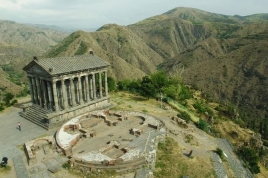Temple of Garni
Tuesday, August 24, 2021
The Temple of Garni is the only standing Greco-Roman colonnaded building in Armenia and the former Soviet Union.
Built-in the Ionic order in the village of Garni, in central Armenia, it is the best-known structure and symbol of pre-Christian Armenia.
The structure was probably built by king Tiridates I in the first century AD as a temple to the sun god Mihr. After Armenia's conversion to Christianity in the early fourth century, it was converted into a royal summer house of Khosrovidukht, the sister of Tiridates III. According to some scholars it was not a temple but a tomb and thus survived the destruction of pagan structures. It collapsed in a 1679 earthquake. Renewed interest in the 19th century led to excavations at the site in early and mid-20th century, and its eventual reconstruction between 1969 and 1975, using the anastylosis method. It is one of the main tourist attractions in Armenia and the central shrine of Hetanism (Armenian neopaganism).
The temple is at the edge of a triangular cliff that overlooks the ravine of the Azat River and the Gegham mountains. It is a part of the fortress of Garni, one of the oldest fortresses in Armenia, that was strategically significant for the defense of the major cities in the Ararat plain. It is mentioned as Gorneas in the first-century Annals of Tacitus. The site is in the village of Garni, in Armenia's Kotayk Province and includes the temple, a Roman bath with a partly preserved mosaic floor with a Greek inscription, a royal summer palace, the seventh century church of St. Sion and other objects (e.g., medieval khachkars).





